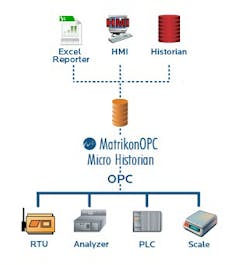Micro Historian Gets You Out of an Excel of a Mess
Off-line analysis of historical process data is an integral part of process optimization and production reporting. Although many organizations have database systems in place for business automation, a substantial percentage of end users are still creating Excel sheets to store and manipulate data. Spreadsheets and other common log file formats are not designed to store long-term data. Such applications do not have adequate support for maintaining data integrity, validations, relations and other features. Using OPC applications designed for each task enables users to follow data management best practices of separating data visualization from data storage.Analysis Needs DataData storage is an important aspect of data acquisition and analysis. While some data acquisition applications involve inline analysis and visualization, others require post-analysis or long-term data trending. Such applications need some method of recording and storing the data. Stored data is valuable only if it can be accessed when needed and is interpretable.All too often data is stored as randomly named Excel files, in inconsistent formats and scattered about on several computers. This creates a black hole of information that makes it difficult to locate a particular data set and derive results from it. Selecting the appropriate file type and storage medium will ensure proper data storage, while meeting application requirements as well as cost and time constraints.One Version of the TruthAt the most basic level, file formats like .csv and .txt are easily accessible with most common word processing and spreadsheet software, allowing for quick access to small data sets and simple visualization. While these file types work for short-term temporary storage, they fail for maintaining long-term data storage. Apart from the security and reliability concerns of using Excel, it also means the data presentation and storage are combined in the same document. Distributing the raw data as part of the report invariably results in “multiple versions of the truth.”Having multiple copies of the source data means that any modifications or aggregation of information must be propagated across all copies. For these reasons it is recommended that users follow industry best practices of separating data storage from data visualization and analysis. Data historians are used in many manufacturing environments that employ process control, supervisory systems or other execution functions requiring real-time data. The OPC Data Access (DA) and the OPC Historical Data Access (HDA) specifications are commonly used to access and historicize the data and make it available to a wide range of analysis, viewing and reporting tools such as the Matrikon Analytics Excel Reporter.Historian for the MassesAlthough a central process historian for an entire organization is a model that has widespread adoption, not all organizations can afford or require a solution of this size. For manufacturers that need to analyze process data, the MatrikonOPC Micro Historian is an affordable and easy to install data archiving tool. Unlike enterprise process historians that are designed to manage the needs of the entire corporation, the Micro Historian is a solution for time-based data storage that can stand-alone or become part of a total enterprise data historian solution. Data is collected via OPC, and accessed via OPC. Thus the MatrikonOPC Micro Historian is a standards-based product that can be combined with any OPC reporting, such as the Matrikon Analytics Excel Reporter, to create a best of breed solution. Choosing the right data storage and data analysis products that use OPC DA and OPC HDA technology provides a simple, cost-effective solution for long-term storage of process data for the few dozen tags engineers typically need for their production reporting and analysis. Employing standards-based connectivity and industrial best practices of separating the data storage from presentation ensure that these reports are secure, reliable and accurate.For more information on OPC solutions from MatrikonOPC, visit www.matrikonopc.com.

